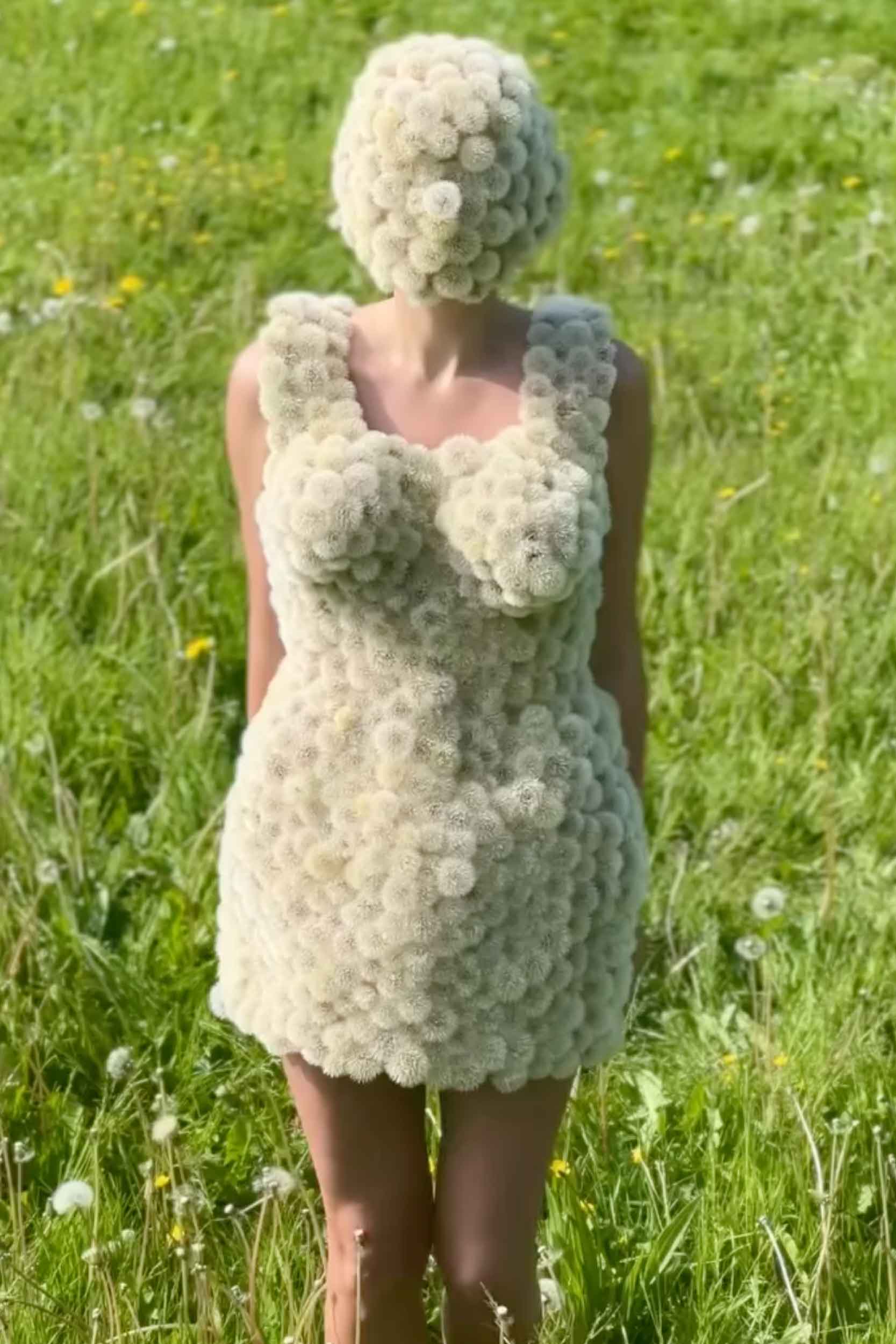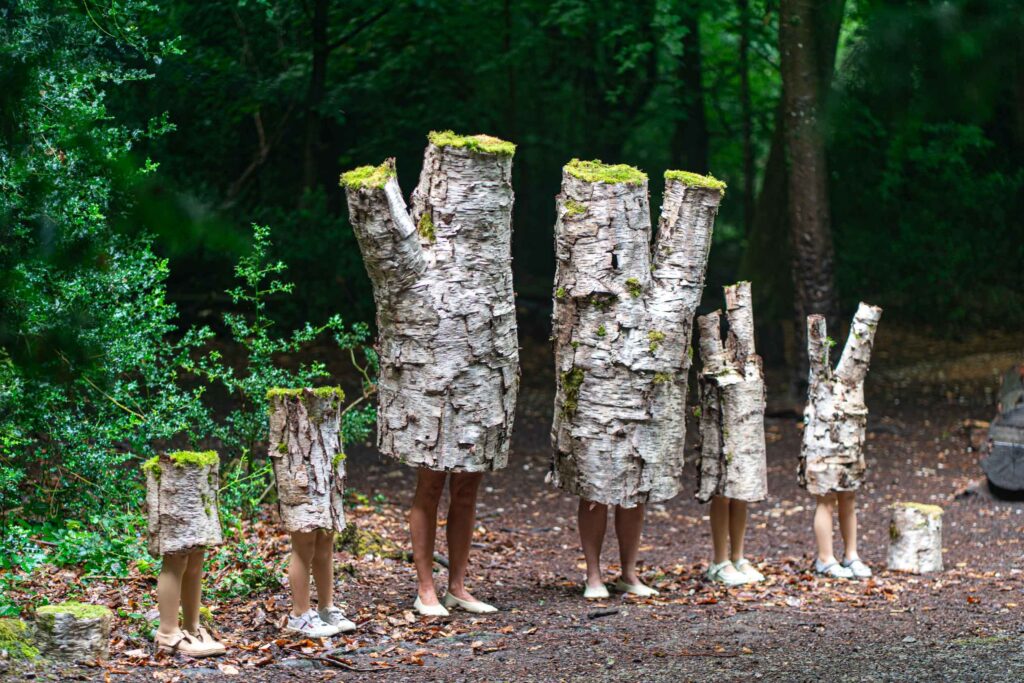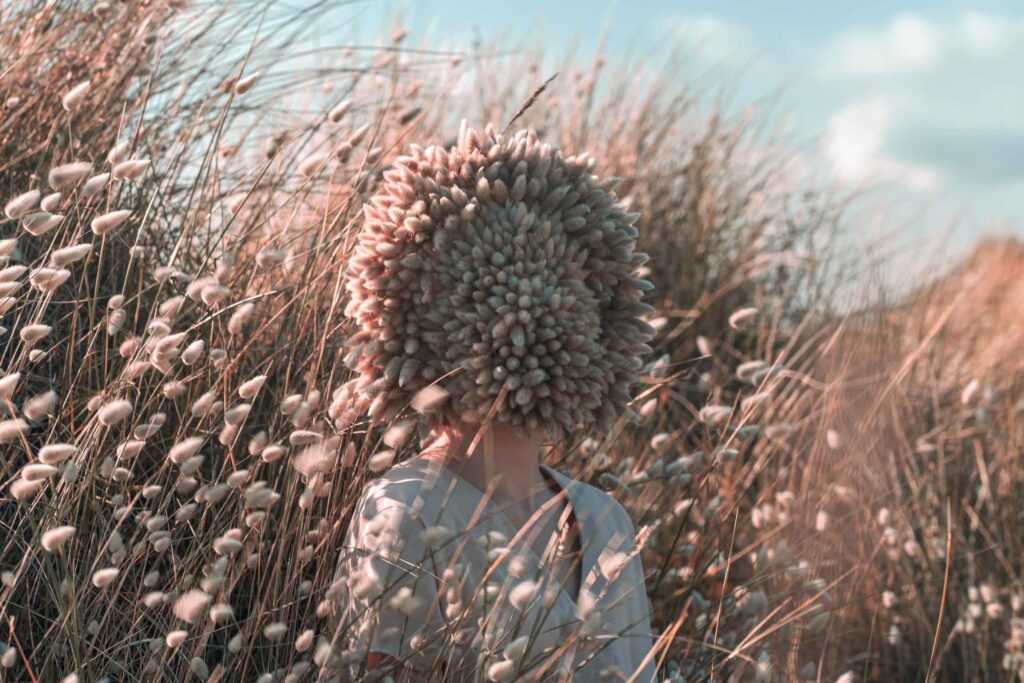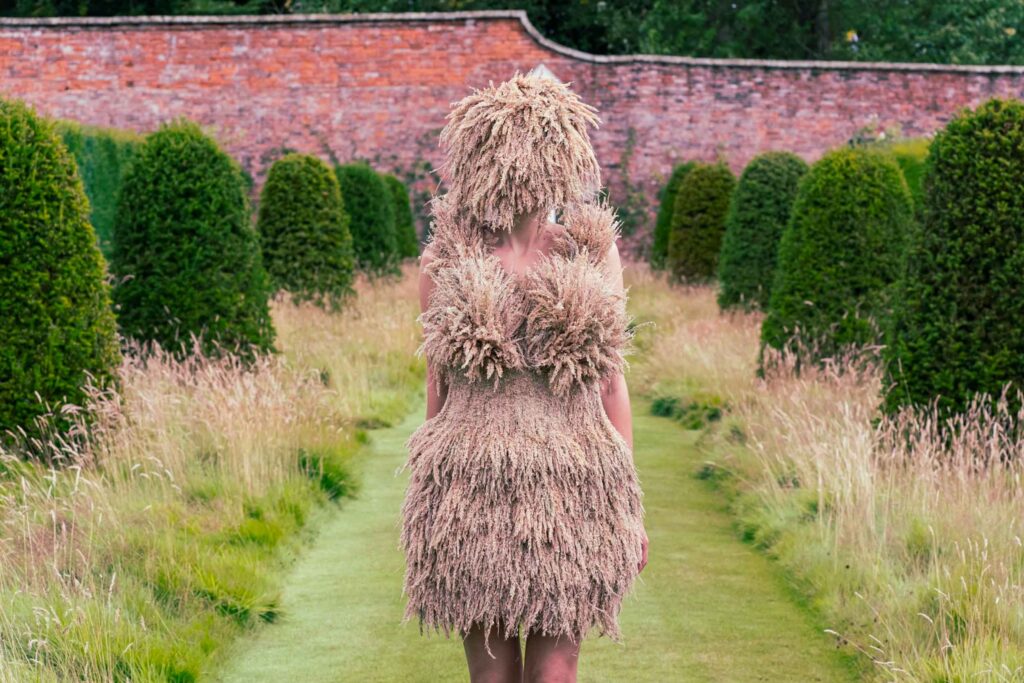
Organic Art: Blurring the Boundaries Between Identity and Nature | Olana Light
The dizzying sweetness of birch resin, the soft fluffiness of green moss underfoot, and the smooth sharpness of palm fronds – these are all things that Olana Light brings to life and intertwines with the human experience in her artwork. Sometimes paired with stilettos, other times with baggy, dark-coloured hoodies, Light’s wearable nature interrogates both the stark contrast and the seamless continuity that exists between humanity and the natural world.
As a multidisciplinary artist, Light’s practice involves performance, sculpture and multimedia images. Her poignant art explores the deep entwinement between human existence and nature, examining both the encompassing power of nature as well as its fragility.
In one piece of performance art, women stroll through the concrete jungle wearing birch trunks, prompting passersby to be shocked and confused at what they see. In another, they blend in without a second thought in a birch-filled park. Themes of femininity are recurring in her work, drawing a parallel between the cyclicity of organic growth and renewal and the inherent affinity of women with the earth and its beings.
Through her reflective work, she pushes the public to explore their relationship with nature and to actively move towards growing in harmony with it, establishing a relationship of respect and gratitude.
Leila El Zabri: How has your upbringing influenced your identity in relation to the natural environment and inspired you to create art that is so interwoven with the essence of nature? Were there any defining moments in your life that brought you on the creative path you find yourself on today?
Olana Light: My connection to the natural environment has always been deeply rooted in my upbringing. However, it took me over thirty years to fully understand its importance in my life and creative practice. I often return to a vivid memory from my childhood—running freely through fields of wildflowers, chasing butterflies, completely immersed in the landscape. There were no adults around, just me and nature. That moment carried a quiet sense of freedom and wonder and a feeling that I was part of something much bigger.
Although I’ve always loved walking and spending time outdoors, it wasn’t until the lockdown—when I lost access to my studio—that nature became central to my artmaking. I began working with materials I found on daily walks in the park. One of the first pieces I created was a self-portrait made from fallen catkins found on the ground. That experience shifted something in me—it was a return to instinct, to childhood, to a simpler and more honest way of creating.
I completed my MFA in Fine Art at Goldsmiths in 2020, and since then, my practice has become increasingly intertwined with the natural world, not only as subject matter but also as material, collaborator, and quiet teacher.
Leila El Zabri: Your project ‘The Birch Tree Family’ aims to communicate the interconnectedness between humans, nature and the environment. Why did you choose the birch tree to express this message, and what does this tree signify to you?
Olana Light: The Birch Tree Family began as a site-specific project developed under the CAS Emerging Sculptors Development Award and was showcased as an outdoor installation at Sir Harold Hillier Gardens from February to April 2024. During a professional development session and site visit, I was drawn to a particular space surrounded by birch trees. That moment shaped the direction of the project. As an artist creating site-specific work through wearable sculpture and performance, I decided to make birch tree-inspired costumes—wearable and static sculptures that would echo the surrounding environment while also symbolising renewal and transformation.
It’s a rare and valuable opportunity as an artist to be invited to respond directly to a landscape in this way, and I was grateful for the chance to let the environment lead the development of the work. The birch tree, known for its resilience and ability to regenerate after disturbance, became a central symbol—reflecting themes of healing, feminine strength, and the cyclical nature of life. By performing as human birch trees within both natural and urban settings, I aim to blur the line between body and landscape—encouraging viewers to consider our interdependence with nature and the fragility of that relationship. The Birch Tree Family is both playful and reflective, using movement, costume, and setting to evoke a sense of connection, memory, and environmental care.
I aim to blur the line between body and landscape—encouraging viewers to consider our interdependence with nature and the fragility of that relationship.
Olana Light
Multidisciplinary Artist

Leila El Zabri: Why did you choose to craft ’The Birch Tree Family’ project specifically for the setting of the Sir Harold Hillier Garden?
Olana Light: The project was born directly from my experience of the site during the CAS Emerging Sculptors Development Award. I was drawn to a quiet area framed by birch trees—a space that felt emotionally resonant and visually rich. It became clear that this environment would shape the heart of the work. The Sir Harold Hillier Gardens, with its focus on biodiversity and seasonal change, offered the ideal setting to explore themes of renewal, connection, and environmental care. Rather than using the landscape as a backdrop, I saw it as an active collaborator—allowing The Birch Tree Family to emerge as a true dialogue between body, sculpture, and place.
Leila El Zabri: Your work brings to the foreground the diachrony between urban life and natural wilderness. What relevance does the setting of your installations have, and how do you view the interactions between day-to-day city bustle and concrete jungles and organic, unobstructed nature?
Olana Light: The setting of my installations is never incidental—it is fundamental to the meaning and emotional impact of the work. Whether in a quiet woodland or a city street, I consider how the environment shapes both the form of the piece and the way audiences experience it.
In The Birch Tree Family, performing as human birch trees in both natural and urban settings creates a deliberate tension. In nature, the work can feel harmonious – almost camouflaged – while in urban spaces, the same forms appear strange, out of place, and even vulnerable. This contrast is central to the project. It reflects the disconnection many of us feel from the natural world, while also suggesting the possibility of reconnection.
I’m interested in how organic presence – embodied through movement, costume, and materials – can momentarily soften or disrupt the hardness of urban life. By placing something living, fluid, and symbolic within the structured, fast-paced environment of the city, I aim to invite pause and reflection. It’s a way of asking: How do we live in better balance with the world around us? Ultimately, the work exists in dialogue with its setting. It brings to the surface our shifting and fragile relationship with nature.
Leila El Zabri: You mention the specific affinity women have with nature, being primary caregivers and symbolizing growth and fertility. What is your view on the role femininity has within nature and the cycle of life? How do you express the unity between women and nature throughout your projects?
Olana Light: In my work, I see femininity not as a fixed identity but as a vital, life-giving force deeply intertwined with the rhythms of nature. Women, often viewed as primary carers, share a symbolic and lived affinity with the cycles of growth, renewal, and vulnerability found in the natural world. The birch tree – central to The Birch Tree Family – embodies these qualities. It’s a pioneer species known for its resilience, regenerative power, and ethereal beauty, often associated with feminine energy. Its ability to thrive after disruption mirrors both the strength and fragility of the feminine experience. Through my performances, I express this unity by physically and emotionally embodying the birch tree. The wearable sculptures I create are not simply costumes – they are extensions of the self. When I move through gardens, forests, or city spaces as a living birch, I am performing a return to nature, inhabiting a space between human and tree, self and environment. It becomes an act of communion – both personal and collective – where I reconnect with what I feel is a spiritual, ancestral bond.
This transformation allows me to explore the blurred boundaries between identity and ecosystem, between body and landscape. The presence of femininity is felt in the care, tenderness, and quiet power the work seeks to convey. By reuniting with the “Birch Tree Family” in natural spaces, I emphasise kinship, cyclical continuity, and the importance of nurturing both the planet and one another. Ultimately, I aim to highlight the interconnectedness of all living things and to advocate for a more attentive, feminine approach to ecological care – one rooted in empathy, presence, and renewal.
The wearable sculptures I create are not simply costumes – they are extensions of the self. When I move through gardens, forests, or city spaces as a living birch, I am performing a return to nature, inhabiting a space between human and tree, self and environment. It becomes an act of communion – both personal and collective – where I reconnect with what I feel is a spiritual, ancestral bond.
Olana Light
Multidisciplinary Artist

Leila El Zabri: Have you found that women face sexism and other challenges in their artistic endeavours? Has this influenced how and why you portray the female figure?
Olana Light: Yes, women in the arts (like in many fields) continue to face systemic challenges, from a lack of representation and funding opportunities to subtle biases around how their work is perceived.
This reality has certainly influenced how and why I portray the female figure. I’m interested in reclaiming femininity as a source of strength, wisdom, and transformation. In The Birch Tree Family, I use the female form not as an object but as a subject – active, present, and integrated with the natural world. By blurring the boundaries between body and landscape, I aim to challenge traditional representations and offer a more fluid, embodied perspective on femininity. Rather than depicting the female figure in a literal or idealised way, I express it through movement, gesture, and material. My work speaks to shared experiences of care, vulnerability, and resilience, qualities often associated with the feminine, and insists on their importance, both artistically and ecologically.
Leila El Zabri: Many of your projects, such as ‘Fly Like a Butterfly’ and ‘Search to Belong’, have a very interactive and theatrical dimension. How has the element of performance influenced your artistic process and your projects’ intentions?
Olana Light: Performance is central to my artistic practice; it transforms the work from a static object into a living experience that invites participation, emotional engagement, and reflection. While some projects like Fly Like a Butterfly and Search to Belong incorporate interaction and theatricality to break down barriers between artist and audience, encouraging active participation, many of my performances are quieter and more symbolic, resembling ritual rather than theatrical shows. This element of performance allows me to explore identity, transformation, and connection in dynamic and nuanced ways. Movement, gesture, and presence add layers of meaning that a purely visual work might not convey.
By embodying ideas through performance, I create spaces where stories and emotions are felt directly, fostering empathy and reflection. Unexpectedness and surprise play an important role in my work. I design performances for everyday walkers and non-art audiences, aiming to gently interrupt their routines, inviting them to pause, think, and carry the experience with them. These subtle moments of encounter – between people, body and environment, and imagination and reality – invite audiences to rethink their relationship with themselves and the world around them, making the experience immersive, personal, and lasting.
Leila El Zabri: You often emphasise both the interconnectedness between humans and nature as well as their fragility and vulnerability. What does vulnerability mean to you, and how do these dynamics influence how you relate to nature?
Olana Light: To me, vulnerability means being open and aware of how fragile we are, both as humans and as part of nature. It’s not about weakness but about recognising that we depend on each other and the environment to survive and grow. This understanding makes me feel connected to nature in a caring and respectful way. I often use fragile natural materials in my work to reflect this delicate balance between strength and vulnerability. It reminds me, and those who experience the work, to be gentle with the world around us and to value its resilience and fragility equally.
By blurring the boundaries between body and landscape, I aim to challenge traditional representations and offer a more fluid, embodied perspective on femininity. Rather than depicting the female figure in a literal or idealised way, I express it through movement, gesture, and material. My work speaks to shared experiences of care, vulnerability, and resilience, qualities often associated with the feminine, and insists on their importance, both artistically and ecologically.
Olana Light
Multidisciplinary Artist

Leila El Zabri: How can art, and the themes you explore in your art specifically, such as the unity between all living beings, act as a force of change in the world? How do you envision these values translating into environmental protection and conservation?
Olana Light: I believe art has the power to create change by touching people on an emotional level, by making them feel, pause, and reflect. The themes I explore, like the unity between all living beings, aim to remind us that we are not separate from nature but part of it. When we feel connected to something, we’re more likely to care for it.
Through symbolic, embodied performances and the use of natural, often fragile materials, I try to create moments that stir empathy and awareness. These small moments can shift perspectives, encouraging people to see the environment not just as a resource but as something alive, interconnected, and deserving of care. I see this as the first step toward change. If we can shift how people feel and think about nature, that shift can ripple outward – into conversation, action, and ultimately, into how we protect and live with the natural world.
Leila El Zabri: Reverence is the deep respect and acknowledgement of the interconnectedness of all beings, recognising the value and significance of every story, culture, and experience. Do you consider your work a reflection of reverence for these connections, and how does that shape the stories you tell through your work?
Olana Light: Yes, I do consider my work a reflection of reverence for nature, for shared human experience, and for the quiet connections that often go unnoticed. For me, reverence means slowing down, listening closely, and approaching the world with care and humility. This deeply influences the stories I tell through my work. Whether I’m performing as a birch tree or creating space for others to pause and reflect, I aim to honour the interconnectedness of all life. My work often draws on symbolism, movement, and natural materials to express respect for the fragile balance we live within. It’s about opening a space where people can reconnect – with themselves, with others, and with nature.
I believe art has the power to create change by touching people on an emotional level, by making them feel, pause, and reflect. The themes I explore, like the unity between all living beings, aim to remind us that we are not separate from nature but part of it. When we feel connected to something, we’re more likely to care for it.
Olana Light
Multidisciplinary Artist
Interview and Introduction by Leila El Zabri
Leila El Zabri is Culture Editor at Planted Journal, through which she explores the overlap between natural, social and political realities. Her interests lie in investigating the often unacknowledged social dynamics that accompany environmental crises, applying an intersectional lens to environmental justice and seeking ways to integrate human existence with nature.




